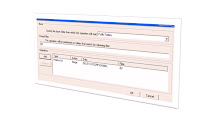
Here is the scenario we will build dedicated public folder server and we will add it into existing PF replica list. While adding the new server into replica list we will delete the one of the dedicated PF server and decommission it eventually. Ideally when it comes to PF design it is a good idea to have the PF folder replica on the local exchange server as well as on the dedicated PF server.
The PFDEVAdmin comes into rescue of course. Doing bulk operation with PFDEVAdmin is real easy.
- Click Tolls
- Click Custom bulk operations
- Click Add
- Replica list click ok
The new menu will appear, and click on "select" under replicas
Here is the trick first window opens up ask you which server you wish to add into PF replica list, if you don't select any server you are leaving it blank, and go to second window (second window ask you which server needs to be removed from replica list) and select the server needs to be removed from PF replica list. Vice versa, if you only want to add without removing existing server when window opens up click okay without selecting any server to accomplish adding and removing PF server into PF tree.
Click ok and start performing bulk operations. PFDEVAdmin is great tool to perform bulk operations in large enterprise environment, altering the PF replica list manually would take up to days.
- There is only one MAPI public folder hierarchy that a single Exchange organization can support.
Another important part of the client public folder experience is the actual Public Folders tree that you can expand to see the public folder hierarchy. The Public Folders object is an Active Directory object that lives under the Administrative Group's Folders object. There is only one MAPI public folder hierarchy that a single Exchange organization can support. This tree object is located in the administrative group that had Exchange 200x installed into it first. The Public Folders object has an attribute that points to every public folder store that is associated with it. You can move this specific object between administrative groups by just dragging and dropping it in Exchange System Manager
Exchange 2007 is still supporting PF architecture; next version of exchange will support it as well (if Microsoft won't change their mind). There is serious intention from Exchange team to drop the PF architecture and use more robust (Share point), type of solution. Eventually PF structure won't be part of exchange, this is the intention and I do support it. In my opinion, the PF folders more of a headache and we need to move away it.
Best Regards,
Oz ozugurlu

No comments:
Post a Comment